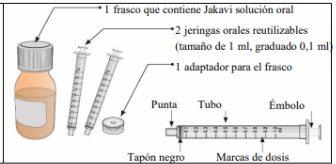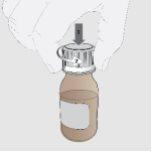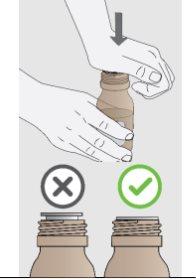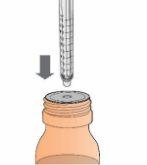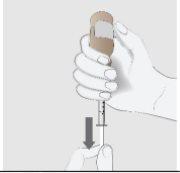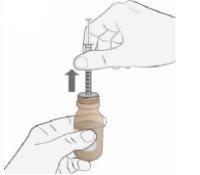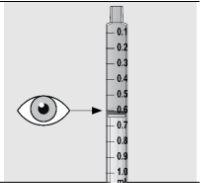
How to use JAKAVI 5 mg/ml ORAL SOLUTION
Introduction
Package Leaflet: Information for the Patient
Jakavi 5 mg/ml Oral Solutionruxolitinib
Read all of this leaflet carefully before you start taking this medicine because it contains important information for you.
- Keep this leaflet, you may need to read it again.
- If you have any further questions, ask your doctor or pharmacist.
- This medicine has been prescribed for you only. Do not pass it on to others. It may harm them, even if their signs of illness are the same as yours.
- If you get any side effects, talk to your doctor or pharmacist. This includes any possible side effects not listed in this leaflet. See section 4.
- The information in this leaflet is for you or your child, although this leaflet refers to "you".
Contents of the pack
- What is Jakavi and what is it used for
- What you need to know before you take Jakavi
- How to take Jakavi
- Possible side effects
- Storage of Jakavi
- Contents of the pack and other information
1. What is Jakavi and what is it used for
Jakavi contains the active substance ruxolitinib.
Jakavi is also used to treat:
- children from 28 days of age or older and adults with acute graft-versus-host disease (aGvHD) and
- children from 6 months of age or older and adults with chronic graft-versus-host disease (cGvHD).
There are two forms of GvHD: an early form called acute GvHD that usually develops shortly after transplantation and can affect the skin, liver, and gastrointestinal tract, and a later form called chronic GvHD, which develops later, usually weeks to months after transplantation. With chronic GvHD, almost any organ can be affected.
How Jakavi works
Graft-versus-host disease is a complication that occurs after a transplant, when specific cells (T cells) from the donor graft (e.g., from bone marrow) do not recognize the recipient's cells/organs and attack them. Jakavi reduces the signs and symptoms of both acute and chronic forms of graft-versus-host disease by selectively blocking enzymes called Janus-associated kinases (JAK1 and JAK2), leading to an improvement in the disease and the survival of transplanted cells.
If you have any questions about how Jakavi works or why you have been prescribed this medicine, ask your doctor.
2. What you need to know before you take Jakavi
Follow carefully all instructions given to you by your doctor. These may be different from the general information contained in this leaflet.
Do not take Jakavi
- if you are allergic to ruxolitinib or any of the other ingredients of this medicine (listed in section 6)
- if you are pregnant or breastfeeding (see section 2 "Do not take Jakavi")
Warnings and precautions
Tell your doctor or pharmacist before you start taking Jakavi if:
- you have any infection. It may be necessary to treat the infection before starting treatment with Jakavi
- you have had tuberculosis or have been in close contact with someone who has or has had tuberculosis. Your doctor may perform tests to see if you have tuberculosis or any other infection
- you have had hepatitis B
- you have kidney or liver problems, as your doctor may need to adjust your dose of Jakavi
- you have or have had cancer, particularly skin cancer
- you have or have had heart problems
- you are over 65 years old. Patients 65 years or older may have a higher risk of heart problems, including heart attack, and some types of cancer
- you smoke or have smoked in the past
Tell your doctor or pharmacist during treatment with Jakavi if:
- you have fever, chills, or other symptoms of infection
- you have a chronic cough with bloody sputum, fever, night sweats, and weight loss (these may be signs of tuberculosis)
- you have any of the following symptoms or if someone close to you notices that you have any of these symptoms: confusion or difficulty reasoning, loss of balance or difficulty walking, lack of coordination (clumsiness), difficulty speaking, decreased strength or weakness on one side of your body, blurred vision and/or loss of vision. These may be signs of a serious brain infection and your doctor may recommend additional tests and monitoring)
- you develop a painful rash with blisters (these are signs of herpes)
- you have any changes in your skin. This may require closer monitoring, as some types of cancer (non-melanoma) have been reported
- you suddenly experience shortness of breath or difficulty breathing, chest pain or pain in the upper back, swelling in the legs or arms, pain or tenderness in the legs, redness or discoloration of the legs or arms, which may be signs of blood clots in the veins
Other medicines and Jakavi
Tell your doctor or pharmacist if you are taking, have recently taken, or might take any other medicines. While taking Jakavi, do not start taking a new medicine without first talking to your doctor who prescribed Jakavi. This includes prescription medicines, over-the-counter medicines, and herbal or alternative medicines.
It is particularly important that you mention medicines that contain any of the following active substances, as your doctor may need to adjust your dose of Jakavi.
- Some medicines used to treat infections:
- medicines used to treat fungal diseases (such as ketoconazole, itraconazole, posaconazole, fluconazole, and voriconazole)
- antibiotics used to treat bacterial infections (such as clarithromycin, telithromycin, ciprofloxacin, or erythromycin)
- medicines used to treat viral infections, including HIV/AIDS (such as amprenavir, atazanavir, indinavir, lopinavir/ritonavir, nelfinavir, ritonavir, saquinavir)
- medicines used to treat hepatitis C (boceprevir, telaprevir)
- a medicine used to treat depression (nefazodone)
- medicines used to treat high blood pressure and angina pectoris (mibefradil or diltiazem)
- a medicine used to treat stomach acid (cimetidine)
- a medicine used to treat heart disease (avasimibe)
- medicines used for seizures or fits (phenytoin, carbamazepine, or phenobarbital and other antiepileptics)
- medicines used to treat tuberculosis (rifabutin or rifampicin)
- a herbal derivative used to treat depression (St. John's Wort (Hypericum perforatum))
Tell your doctor if you are not sure if the above applies to you.
Pregnancy, breastfeeding, and contraceptives
Pregnancy
- If you are pregnant or think you may be pregnant or are planning to have a baby, ask your doctor or pharmacist for advice before taking this medicine.
- Do not take Jakavi during pregnancy (see section 2 "Do not take Jakavi").
Breastfeeding
- Do not breastfeed while taking Jakavi (see section 2 "Do not take Jakavi").
Ask your doctor.
Contraceptives
- It is not recommended to take Jakavi in women who may become pregnant and are not using contraception. Discuss with your doctor the most suitable contraceptive methods to avoid becoming pregnant while taking Jakavi.
- Tell your doctor if you become pregnant while taking Jakavi.
Driving and using machines
If you feel dizzy after taking Jakavi, do not drive, ride a bike, use machines, or engage in any activity that requires you to be alert.
Jakavi contains propylene glycol
This medicine contains 150 mg of propylene glycol in each ml of oral solution.
If the child is under 5 years of age, ask your doctor or pharmacist, especially if they have been given other medicines that contain propylene glycol or alcohol.
Jakavi contains methyl and propyl p-hydroxybenzoates
May cause allergic reactions (possibly delayed).
3. How to take Jakavi
Follow exactly the instructions of administration of this medicine given to you by your doctor or pharmacist. If you are not sure, ask your doctor or pharmacist again.
Before starting treatment with Jakavi and during your treatment, your doctor will perform a blood test to determine the best initial dose for you, to see how you are responding to treatment, and if Jakavi is having an unwanted effect. Your doctor may need to adjust the dose or interrupt treatment. Before starting your treatment and during treatment with Jakavi, your doctor will check that you do not have signs or symptoms of infection.
You should take Jakavi twice a day, approximately at the same time each day. Your doctor will tell you what your dose is. Always follow the instructions given by your doctor. Jakavi can be taken with or without food. You can take a little water afterwards to make sure you have swallowed the complete dose.
You should continue taking Jakavi for as long as your doctor tells you.
For instructions on how to use the oral solution, see "Instructions for use" at the end of this leaflet.
Jakavi tablets are available for patients over 6 years who can swallow whole tablets.
If you take more Jakavi than you should
If you accidentally take more Jakavi than your doctor has prescribed, contact your doctor or pharmacist immediately.
If you forget to take Jakavi
If you have missed a dose, simply take the next dose at the scheduled time. Do not take a double dose to make up for forgotten doses.
If you have any further questions on the use of this product, ask your doctor or pharmacist.
4. Possible side effects
Like all medicines, Jakavi can cause side effects, although not everybody gets them.
Most side effects of Jakavi are mild to moderate and usually disappear after a few days to a few weeks of treatment.
Some side effects can be serious
Seek medical attention immediately before taking the next dose if you notice any of the following serious side effects:
Very common (may affect more than 1 in 10 people):
- signs of infection with associated fever:
- muscle pain, skin redness, and/or difficulty breathing (cytomegalovirus infection)
- painful urination (urinary tract infection)
- rapid heartbeat, confusion, and rapid breathing (sepsis, which is a disease associated with infection and generalized inflammation)
- frequent infections, fever, chills, sore throat, or mouth ulcers
- spontaneous bleeding or bruising - possible symptoms of thrombocytopenia caused by low platelet levels
Other side effects
Very common (may affect more than 1 in 10 patients):
- headache
- high blood pressure (hypertension)
- abnormal blood test results:
- high lipase and/or amylase levels
- high cholesterol levels
- abnormal liver function
- increased levels of the muscle enzyme (increased creatine phosphokinase in blood)
- increased levels of creatinine, an enzyme that indicates that your kidneys are not working properly
- low counts of all three types of blood cells: red blood cells, white blood cells, and platelets (pancytopenia)
- nausea
- fatigue, tiredness, paleness - possible symptoms of anemia caused by low red blood cell levels
Common (may affect up to 1 in 10 patients):
- fever, muscle pain, or difficulty urinating, blurred vision, cough, cold, or difficulty breathing - possible symptoms of BK virus infection
- weight gain
- constipation
Reporting of side effects
If you experience any side effects, talk to your doctor or pharmacist, even if they are not listed in this leaflet. You can also report side effects directly via the national reporting system listed in Annex V. By reporting side effects, you can help provide more information on the safety of this medicine.
5. Storage of Jakavi
Keep this medicine out of the sight and reach of children.
Do not use this medicine after the expiry date which is stated on the carton or bottle after "EXP".
Do not store above 30°C.
Once opened, use within 60 days.
Medicines should not be disposed of via wastewater or household waste. Ask your pharmacist how to dispose of medicines no longer required. This will help protect the environment.
6. Container Contents and Additional Information
Jakavi Composition
- The active ingredient of Jakavi is ruxolitinib.
- Each ml of solution contains 5 mg of ruxolitinib.
- The other components are: propylene glycol (E 1520) (see section 2), anhydrous citric acid, methyl p-hydroxybenzoate (E 218) (see section 2), propyl p-hydroxybenzoate (E 216) (see section 2), sucralose (E 955), strawberry flavor, purified water.
Product Appearance and Container Contents
Jakavi 5 mg/ml oral solution is a clear, colorless to light yellow solution that may contain a few small, colorless particles or a small amount of sediment.
Jakavi oral solution is available in amber glass bottles with a white polypropylene screw cap, resistant to children.
The container contains a bottle with 60 ml of oral solution, two 1 ml oral syringes, and a bottle adapter.
Marketing Authorization Holder
Novartis Europharm Limited
Vista Building
Elm Park, Merrion Road
Dublin 4
Ireland
Manufacturer
Novartis Farmacéutica S.A.
Gran Via de les Corts Catalanes, 764
08013 Barcelona
Spain
Novartis Pharma GmbH
Roonstrasse 25
90429 Nürnberg
Germany
Novartis Pharma GmbH
Sophie-Germain-Strasse 10
90443 Nürnberg
Germany
You can request more information about this medicine by contacting the local representative of the marketing authorization holder:
Belgium Novartis Pharma N.V. Tel: +32 2 246 16 11 | Lithuania SIA Novartis Baltics Lietuvos filialas Tel: +370 5 269 16 50 |
| Luxembourg Novartis Pharma N.V. Tel: +32 2 246 16 11 |
Czech Republic Novartis s.r.o. Tel: +420 225 775 111 | Hungary Novartis Hungária Kft. Tel: +36 1 457 65 00 |
Denmark Novartis Healthcare A/S Tel: +45 39 16 84 00 | Malta Novartis Pharma Services Inc. Tel: +356 2122 2872 |
Germany Novartis Pharma GmbH Tel: +49 911 273 0 | Netherlands Novartis Pharma B.V. Tel: +31 88 04 52 111 |
Estonia SIA Novartis Baltics Eesti filiaal Tel: +372 66 30 810 | Norway Novartis Norge AS Tel: +47 23 05 20 00 |
Greece Novartis (Hellas) A.E.B.E. Tel: +30 210 281 17 12 | Austria Novartis Pharma GmbH Tel: +43 1 86 6570 |
Spain Novartis Farmacéutica, S.A. Tel: +34 93 306 42 00 | Poland Novartis Poland Sp. z o.o. Tel: +48 22 375 4888 |
France Novartis Pharma S.A.S. Tel: +33 1 55 47 66 00 | Portugal Novartis Farma - Produtos Farmacêuticos, S.A. Tel: +351 21 000 8600 |
Croatia Novartis Hrvatska d.o.o. Tel: +385 1 6274 220 | Romania Novartis Pharma Services Romania SRL Tel: +40 21 31299 01 |
Ireland Novartis Ireland Limited Tel: +353 1 260 12 55 | Slovenia Novartis Pharma Services Inc. Tel: +386 1 300 75 50 |
Iceland Vistor hf. Tel: +354 535 7000 | Slovakia Novartis Slovakia s.r.o. Tel: +421 2 5542 5439 |
Italy Novartis Farma S.p.A. Tel: +39 02 96 54 1 | Finland Novartis Finland Oy Tel: +358 (0)10 6133 200 |
Cyprus Novartis Pharma Services Inc. Tel: +357 22 690 690 | Sweden Novartis Sverige AB Tel: +46 8 732 32 00 |
Latvia SIA Novartis Baltics Tel: +371 67 887 070 |
Date of Last Revision of this Leaflet
Other Sources of Information
Detailed information on this medicine is available on the European Medicines Agency website: http://www.ema.europa.eu.
Instructions for Use
Jakavi 5 mg/ml Oral Solution
Read these "Instructions for Use" carefully before starting to use Jakavi. Your healthcare professional should teach you how to measure and administer a dose of Jakavi correctly. If you have any questions about the use of Jakavi, talk to your healthcare professional.
The Jakavi container should contain: |
|
IMPORTANT INFORMATION | |
|
Administration | |
If Jakavi oral solution comes into contact with the skin, wash the area immediately with soap and water. If Jakavi oral solution comes into contact with the eyes, rinse them immediately with cold water. | |
Do not administerJakavi oral solution if the security seal is broken or the medicine is expired. | |
Remove the child-resistant cap by pressing down and turning the cap counterclockwise. Write the date of first opening on the bottle label. |
|
This only needs to be done the first time, as the adapter should be left on the bottle. Important:Inserting the adapter may require significant force. Press firmly until it is fully inserted. The adapter should be completely flush with the bottle and no edges should be visible. |
|
| |
Press down to ensure the syringe is securely attached. |
|
Note:Small air bubbles are normal. |
|
Gently pull the syringe out of the bottle. |
|
If not, repeat the measurement steps. |
|
Place the syringe tip inside the mouth, with the tip touching the inside of either cheek. Slowly push the plunger to the bottom to administer the prescribed dose of Jakavi oral solution. WARNING:Administering in the throat or pushing the plunger too quickly can cause choking. |
|
The child can be given a little water after administration to ensure they have swallowed the full dose of Jakavi oral solution. Note:If the prescribed dose requires using the syringe twice, repeat the administration steps until the prescribed dose has been administered. | |
Put the child-resistant cap back on the bottle and turn it clockwise to close it. Make sure the cap is securely attached to the bottle. |
Syringe Cleaning |
Note: Keep the oral syringe separate from other kitchen items to keep it clean. |
|
Pull the plunger up and down to pull water into and out of the syringe 4-5 times. |
|
Rinse the glass, plunger, and tube with warm tap water. |
Alwayskeep the syringe out of the reach of children. |
Administration through a Feeding Tube |
|
- Country of registration
- Active substance
- Prescription requiredYes
- Manufacturer
- This information is for reference only and does not constitute medical advice. Always consult a licensed doctor before taking any medication. Oladoctor is not responsible for medical decisions based on this content.
- Alternatives to JAKAVI 5 mg/ml ORAL SOLUTIONDosage form: TABLET, 10 mgActive substance: ruxolitinibManufacturer: Novartis Europharm LimitedPrescription requiredDosage form: TABLET, 15 mgActive substance: ruxolitinibManufacturer: Novartis Europharm LimitedPrescription requiredDosage form: TABLET, 20 mgActive substance: ruxolitinibManufacturer: Novartis Europharm LimitedPrescription required
Alternatives to JAKAVI 5 mg/ml ORAL SOLUTION in other countries
The best alternatives with the same active ingredient and therapeutic effect.
Alternative to JAKAVI 5 mg/ml ORAL SOLUTION in Ukraina
Online doctors for JAKAVI 5 mg/ml ORAL SOLUTION
Discuss dosage, side effects, interactions, contraindications, and prescription renewal for JAKAVI 5 mg/ml ORAL SOLUTION – subject to medical assessment and local rules.





